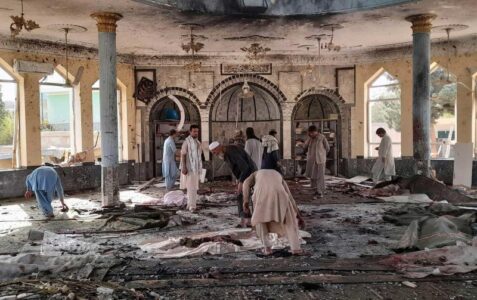
ISIS morphs into borderless terrorist group in South Asia
Since coming to power in Afghanistan eight months ago, the Taliban have touted their success in repressing the Islamic State (ISIS) extremist group, but the terrorist organisation’s footprint has expanded into neighbouring Pakistan, stepping up attacks there.
Analysts say ISIS has morphed into a borderless terrorist group, one of the deadliest in a region that has spawned many violent, radical organisations.
In northwest Pakistan, the impact is brutally clear. The remains of an ISIS suicide bomber are still visible on the once ornate walls of a mosque, weeks after he blew himself up, killing more than 60 worshippers as they prayed. ISIS identified the bomber as an Afghan from Kabul.
The March 4 bombing at the Kusha Kisaldar Shia mosque in the old city of Peshawar stunned Pakistanis, deepening their fear of the resurgence of terror attacks in their country, after a steady decline in the past decade.
The rise in attacks began last year and is accelerating, said Amir Rana, executive director of the Pakistan Institute of Peace Studies, an independent think tank that monitors militant activity in Pakistan.
By late March this year, Pakistan had seen 52 attacks by militants, compared to 35 in the same period last year, according to the institute’s data. The attacks have also become deadlier. So far this year in Pakistan, 155 people have been killed in such strikes, compared to 68 last year.
The worst have been claimed by a ruthless Islamic State (ISIS) affiliate, known Islamic State in Khorasan Province or ISIS-K.
Meanwhile, ISIS attacks appear to have declined in Afghanistan.
ISIS-K first emerged in 2014 in eastern Afghanistan. By 2019, it held significant territory in Nangarhar province and had pushed into neighbouring Kunar province. The US military waged a massive air campaign against it, including targeting a suspected ISIS hideout with America’s largest conventional bomb, known as the “mother of all bombs.”
But ISIS survived and it presented the greatest security challenge to the Taliban when they seized power in Afghanistan last August.
ISIS-K is a longtime enemy of the Taliban. The Taliban espouse a harsh interpretation of Islamic law and often used suicide attacks in their nearly 20-year insurgency against the United States and its Afghan allies. But they often blend tribal traditions with religious edicts and have reached out to Shia. ISIS, meanwhile, rejects any group that does not accept its totalitarian, deeply anti-Shia ideology and is notorious for atrocities meant to spread fear. ISIS, unlike the Taliban, see their battle as one to establish a unified Muslim world under a caliphate.
The Taliban responded with their characteristic bloodshed, sweeping through suspected ISIS strongholds. In October and November, residents reported bodies hanging from trees. They were told they were ISIS extremists.
The Taliban intelligence chief in eastern Afghanistan, known as “Basheer”, says the Taliban have succeeded in reining in the group.
“We got control of all those areas … Right now, there might be some people who hid in houses (but) they don’t have any area under their control. There is no Daesh,” he said, using the Arabic acronym for ISIS.
He said ISIS-K fighters are at a disadvantage because the Taliban are longtime masters of guerrilla warfare. The ISIS-K has no tactics that the Taliban do not already know or have not used, he said.
Some militancy watchers also say the Taliban’s deep reach inside Afghan villages and links to mosques and madrassas in even the smallest hamlets have reduced the space for ISIS to operate.
Since the chaotic US withdrawal from Afghanistan last year, Washington’s ability to gather intelligence on ISIS has been drastically degraded, according to senior US military officials.
The region is also increasingly inhospitable to America. Political turmoil has fuelled anti-US sentiment in Pakistan. In Afghanistan, the Taliban are imposing a rule that harks to their harsh government of the late 1990s. China is a major player in the region, quickly outstripping US influence.
ISIS-K is not the only extremist group in the region. Others include Lashkar-e-Taiba, which is largely India-focused, China’s Uyghur rebels of the East Turkestan group and Central Asia’s rebel Islamic Movement of Uzbekistan.
The threat from ISIS has only become more fluid and difficult to control.
Dr Amira Jadoon, assistant professor at the Combatting Terrorism Centre at the US Military Academy at West Point, said ISIS-K is weaker than it was in 2019. But it has morphed from an insurgency to a typical terrorist group, a subtle but important difference, she said.
“It’s now a stronger terrorist group than it was in 2019, but perhaps a weaker ‘insurgency’ compared to its earlier peak years, since it lacks the same level of territorial control and is not controlling any civilian populations,” Jadoon said.
A February UN report estimated the number of ISIS-K fighters at around 4,000 and said it “enjoys more freedom than at any time in recent history.”
Not everyone agrees. Bill Roggio, whose Long War Journal tracks extremist movements, said the Taliban sweep to power prompted some former member of the group who had defected to ISIS-K to return to the Taliban fold.
“The Taliban received a major boost after its victory in Afghanistan,” said Roggio, who is also a senior fellow at the conservative Foundation for the Defence of Democracies.
Unlike in Afghanistan, ISIS-K has not tried to lay claim to territory in Pakistan.
Instead, it has often piggy-backed on well-established anti-Shia groups like Lashkar-e-Jhangvi, which has claimed scores of brutal attacks on Pakistan’s Shia Muslim minority.
Rana, from the Pakistani militancy monitoring group, said ISIS likely aims to stir up tensions between Islamabad and Kabul. But he said Pakistani authorities still consider the Pakistani Taliban, a homegrown anti-government group, the main threat.
“This is quite a naïve and simplistic view,” he said, warning that ISIS attacks are likely to only increase.
Source: The Arab Weekly





